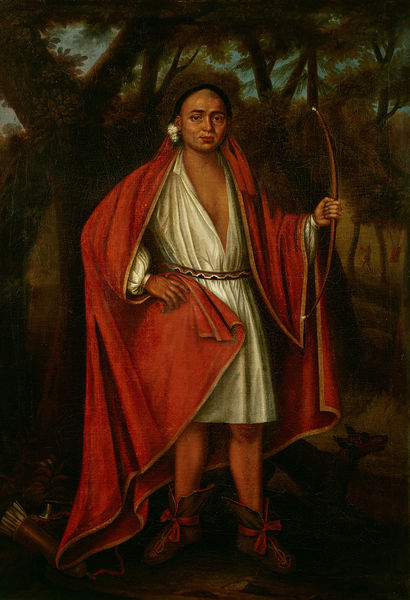In 1710 Queen Anne received royal visitors. These four unique visitors were not from the gilded courts of Europe but from the rustic forests of the New World.
"The Four Kings" as they were called, were originally five, and were chiefs and representatives of their respected tribes. The MC or tour organizer of this momentous event was Peter Schuyler, a Dutch-American and governor of New York. Schuyler recruited the "chiefs" to ask the queen for military support against the French who were becoming too close for the Dutch and natives to be comfortable. The three Mohawks and one Mahican* (all of the Iroquois Nation) received the royal treatment and were taken about in royal carriages to see the sights of London including the Tower of London and St Paul's.
The kings were given scarlet cloaks as gifts and Queen Anne commissioned portraits of them in their new cloaks to commemorate the visit. Prints were made of the portraits and were popular due to the curiosity evoked by the unusual foreigners. The portraits hung in Kensington Palace for centuries before Queen Elizabeth II decided it would be more appropriate for they to be moved to Canada, despite all the sitters' all being from New York. The oil paintings are small but quite captivating, and one can look on them in wonder today in perhaps the same wonder they were looked upon when Jan Verelst first painted them. Each man stands in and gestures in the common Western style of the time, but were portrayed in their native clothing.
Sa Ga Yeath Qua Pieth Tow of the Bear Clan, "King of the Maquas" (recognize that name from Last of the Mohicans?) was not an actual chief. He proudly shows his tattoos which must have looked quite fierce to the Londoners who beheld him. The Mohawk is depicted with a rifle with his hatchet at his feet, perhaps symbolizing his openness to his tribe's relationship with Great Britain. The creature behind him is actually a bear (we can assume Verelst never saw one) representing his clan. Sa Ga Yeath Qua Pieth Tow would take the Christian name of Peter Brant and was the grandfather of Joseph Brant who would later trump his grandfather's fame.
Ho Nee Yeath Taw No Row (literally, "great boiling pot") was another non-chief from the Mohawk. he would later be known as John of Canojaharie. He is depicted holding a bow that looks too incredibly small to be accurate. Behind him is a ferocious wolf representing Ho Nee Yeath Taw No Row's clan.
Tee Yee Neen Ho Ga Row (literally, "double life") was also of the Wolf Clan (although not born into), as can be determined by the wolf behind him. He was actually the son of a Mohawk woman and Mohegan (not Mahican) father, born in what is now Massachusetts. He wears the clothing of the Dutch settlers and holds up a wampum belt. Theyanoguin (ahhh, isn't it so much easier to read that way!) was a sachem and would take the Christian name of Hendrick Peters. He would later be known as "King Hendrick" and was devoted to the crown, dying while fighting with the English in a French and Indian War battle in Lake George. Later portrayals of him depict him in the emblematic red coat of the English Army.
Etow Oh Koam King of the River Nation was the only non-Mohawk (and therefore non-Iroquois) of the group. The Mahicans considered themselves the people of the River Nation and this representative hailed from the Turtle Clan as Verelst struggled depicting with the awkward turtle sulking on the ground. Etow Oh Koam holds a tomahawk and wears an English saber around his waist to show his connection to the two nations.
*Not to be confused with the Mohegan tribe of which would be represented twelve years later in a royal visit requesting the English settlers not take so much of their land in modern-day Connecticut





Very interesting! Thank you.
ReplyDeleteGlad you enjoyed!
ReplyDeleteVery handsome gentleman. Any pictures of ladies? R
ReplyDeleteI've found more allegorical images of ladies than ones I'm willing to believe but I will look into it!
ReplyDelete